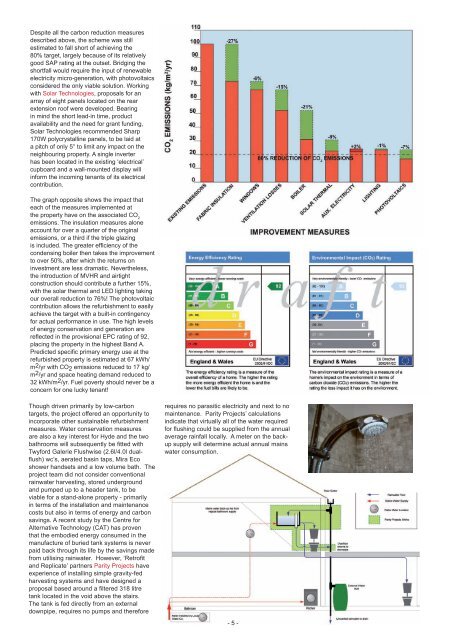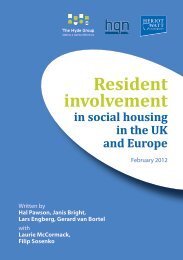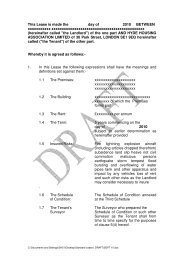Retrofit & Replicate - Hyde Housing Association
Retrofit & Replicate - Hyde Housing Association
Retrofit & Replicate - Hyde Housing Association
Create successful ePaper yourself
Turn your PDF publications into a flip-book with our unique Google optimized e-Paper software.
Despite all the carbon reduction measures<br />
described above, the scheme was still<br />
estimated to fall short of achieving the<br />
80% target, largely because of its relatively<br />
good SAP rating at the outset. Bridging the<br />
shortfall would require the input of renewable<br />
electricity micro-generation, with photovoltaics<br />
considered the only viable solution. Working<br />
with Solar Technologies, proposals for an<br />
array of eight panels located on the rear<br />
extension roof were developed. Bearing<br />
in mind the short lead-in time, product<br />
availability and the need for grant funding,<br />
Solar Technologies recommended Sharp<br />
170W polycrystalline panels, to be laid at<br />
a pitch of only 5° to limit any impact on the<br />
neighbouring property. A single inverter<br />
has been located in the existing ‘electrical’<br />
cupboard and a wall-mounted display will<br />
inform the incoming tenants of its electrical<br />
contribution.<br />
The graph opposite shows the impact that<br />
each of the measures implemented at<br />
the property have on the associated CO 2<br />
emissions. The insulation measures alone<br />
account for over a quarter of the original<br />
emissions, or a third if the triple glazing<br />
is included. The greater efficiency of the<br />
condensing boiler then takes the improvement<br />
to over 50%, after which the returns on<br />
investment are less dramatic. Nevertheless,<br />
the introduction of MVHR and airtight<br />
construction should contribute a further 15%,<br />
with the solar thermal and LED lighting taking<br />
our overall reduction to 76%! The photovoltaic<br />
contribution allows the refurbishment to easily<br />
achieve the target with a built-in contingency<br />
for actual performance in use. The high levels<br />
of energy conservation and generation are<br />
reflected in the provisional EPC rating of 92,<br />
placing the property in the highest Band A.<br />
Predicted specific primary energy use at the<br />
refurbished property is estimated at 67 kWh/<br />
m 2 /yr with CO 2 emissions reduced to 17 kg/<br />
m 2 /yr and space heating demand reduced to<br />
32 kWh/m 2 /yr. Fuel poverty should never be a<br />
concern for one lucky tenant!<br />
Though driven primarily by low-carbon<br />
targets, the project offered an opportunity to<br />
incorporate other sustainable refurbishment<br />
measures. Water conservation measures<br />
are also a key interest for <strong>Hyde</strong> and the two<br />
bathrooms will subsequently be fitted with<br />
Twyford Galerie Flushwise (2.6l/4.0l dualflush)<br />
wc’s, aerated basin taps, Mira Eco<br />
shower handsets and a low volume bath. The<br />
project team did not consider conventional<br />
rainwater harvesting, stored underground<br />
and pumped up to a header tank, to be<br />
viable for a stand-alone property - primarily<br />
in terms of the installation and maintenance<br />
costs but also in terms of energy and carbon<br />
savings. A recent study by the Centre for<br />
Alternative Technology (CAT) has proven<br />
that the embodied energy consumed in the<br />
manufacture of buried tank systems is never<br />
paid back through its life by the savings made<br />
from utilising rainwater. However, ‘<strong>Retrofit</strong><br />
and <strong>Replicate</strong>’ partners Parity Projects have<br />
experience of installing simple gravity-fed<br />
harvesting systems and have designed a<br />
proposal based around a filtered 318 litre<br />
tank located in the void above the stairs.<br />
The tank is fed directly from an external<br />
downpipe, requires no pumps and therefore<br />
requires no parasitic electricity and next to no<br />
maintenance. Parity Projects’ calculations<br />
indicate that virtually all of the water required<br />
for flushing could be supplied from the annual<br />
average rainfall locally. A meter on the backup<br />
supply will determine actual annual mains<br />
water consumption.<br />
- 5 -

















